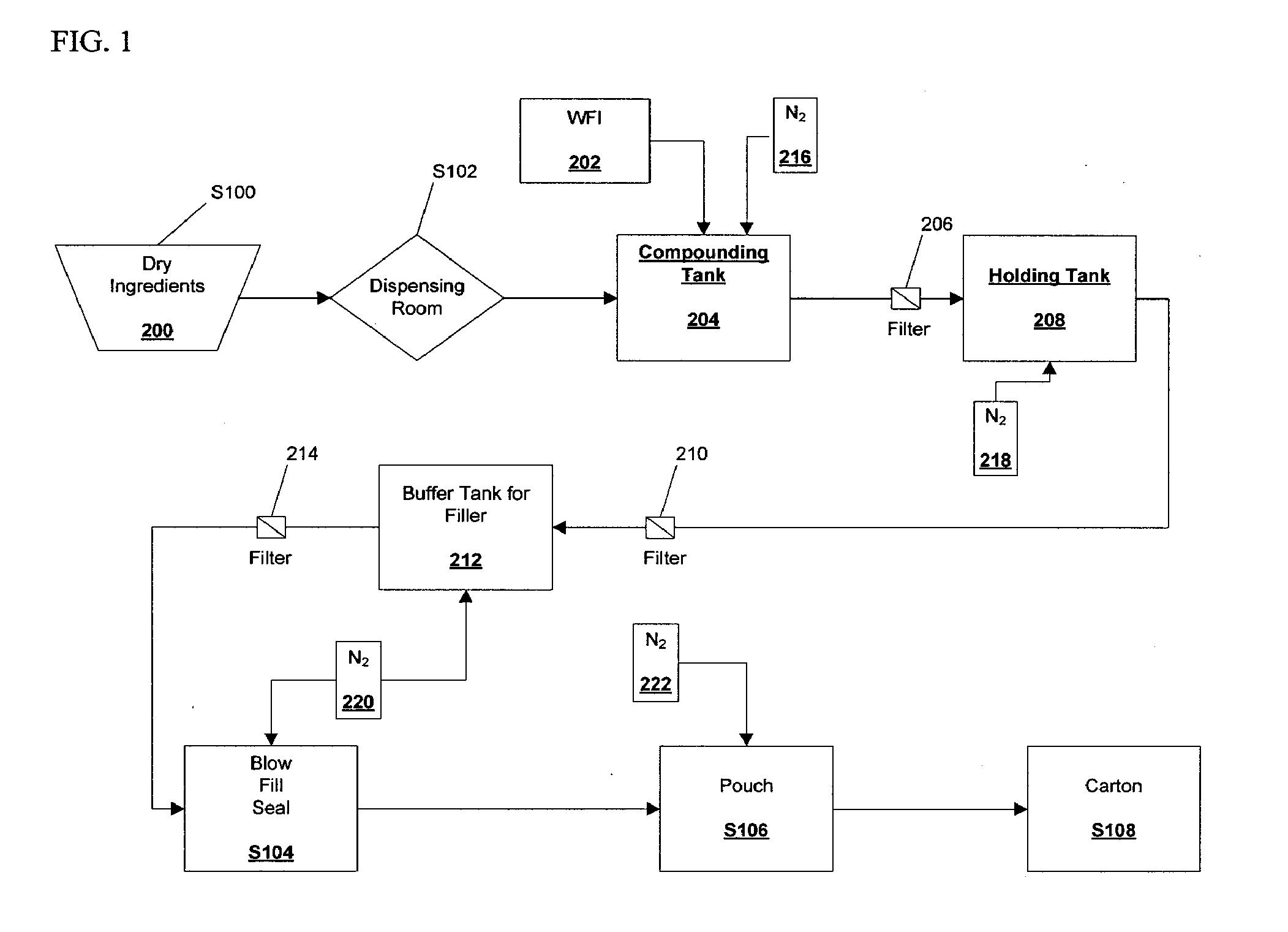Sterilization of corticosteroids with reduced mass loss
- Summary
- Abstract
- Description
- Claims
- Application Information
AI Technical Summary
Benefits of technology
Problems solved by technology
Method used
Image
Examples
example 1
Preparation of 120 Microgram / Milliliter Budesonide Solution
[0055]A 50 L batch of budesonide solution (nominally 120 μg / ml) was prepared according to the following procedure:
[0056]Prior to weighing the Captisole cyclodextrin (Cyclodextrin) and budesonide, the starting materials were assayed. The assay values were used to calculate the actual amount of Cyclodextrin and budesonide starting materials to be used in the formulation. The Cyclodextrin was found to be 4.9% water (95.1% Cyclodextrin). Thus, the total amount of Cyclodextrin starting material was increased by a proportional amount. It was calculated that the amount of Cyclodextrin starting material needed was 935.8569 g (representing 890.0 g Cyclodextrin). This Cyclodextrin starting material was weighed out in three measure: 735.86 g, 100.0 g and 100.0 g. In the same way, the budesonide starting material was assayed and found to contain 98.2% budesonide base. The amount of budesonide starting material was then calculated to be ...
example 2
[0062]The homogenized budesonide solution from Example 1 was filtered through a 0.22 μm Millipore (CVGL71TP3) filter through a Teflon® hose into a sterilized holding tank. An overpressure of about 1200 mbar of nitrogen was applied to the filtered solution.
[0063]After the sterilized budesonide solution was collected in the holding tank, it was assayed. The budesonide solution was found to contain 98.2±0.5% of the theoretical concentration of budesonide, based upon the amount of budesonide in the budesonide starting material. The solution passed sterility according to USP and PhEur 2.6.1.
[0064]As can be seen from Example 2, the present invention provides a method of sterilizing a budesonide solution, wherein the mass loss and the decrease in budesonide concentration levels is low. The invention this provides a practical method for making sterilized budesonide solutions that are suitable for inhalation therapy.
example 3
80 Microgram / Milliliter Budesonide Solution (Batch G1059)
[0065]A 50 L batch of budesonide solution having a final concentration of approximately 80 μg / ml was prepared according to the following procedure.
[0066]First budesonide and Captisol® cyclodextrin (Cyclodextrin) were assayed to determine the percent water in each sample. The target mass of cyclodextrin in the 50 L batch was 595 g; and the target mass of budesonide was 4.1 g. The assay for Cyclodextrin gave a value of 4.8% water or 95.2% Cyclodextrin; the budesonide assay gave a percent budesonide value of 99.2%. Thus, the amount of Cyclodextrin was calculated to be 595 g / 0.952=625 g Cyclodextrin; the budesonide mass was calculated to be 4.1 g / 0.992=4.133 g budesonide.
[0067]The cyclodextrin was weighed out in three aliquots of 100 g, 100 g and 425 g of cyclodextrin, respectively. Precisely 4.133 g of budesonide were weighed out in a container (budesonide container).
[0068]A cleaned holding tank was steam sterilized and 40 kg of ...
PUM
| Property | Measurement | Unit |
|---|---|---|
| Fraction | aaaaa | aaaaa |
| Fraction | aaaaa | aaaaa |
| Fraction | aaaaa | aaaaa |
Abstract
Description
Claims
Application Information
 Login to View More
Login to View More - R&D
- Intellectual Property
- Life Sciences
- Materials
- Tech Scout
- Unparalleled Data Quality
- Higher Quality Content
- 60% Fewer Hallucinations
Browse by: Latest US Patents, China's latest patents, Technical Efficacy Thesaurus, Application Domain, Technology Topic, Popular Technical Reports.
© 2025 PatSnap. All rights reserved.Legal|Privacy policy|Modern Slavery Act Transparency Statement|Sitemap|About US| Contact US: help@patsnap.com


